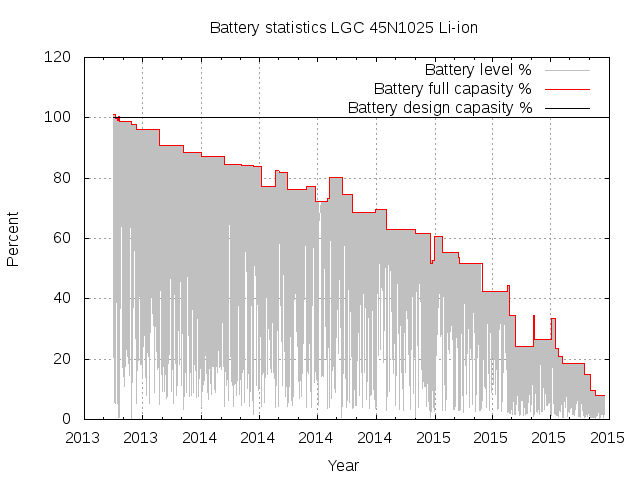When I get a new laptop, the battery life time of the lap top at -the start is OK. But this do not last. I got a feeling that within a -year, the life time is just a fraction of what it used to be, and it -slowly become painful to use the laptop without power connected to it. -Because of this, when I got a new Thinkpad X230 laptop almost two -years ago, I decided to monitor its state to have more hard facts when -the battery started to fail.
+When I get a new laptop, the battery life time at the start is OK. +But this do not last. The last few laptops gave me a feeling that +within a year, the life time is just a fraction of what it used to be, +and it slowly become painful to use the laptop without power connected +all the time. Because of this, when I got a new Thinkpad X230 laptop +about two years ago, I decided to monitor its battery state to have +more hard facts when the battery started to fail.
 @@ -30,8 +30,8 @@ available in Debian.
battery stats ever since. Now my
/var/log/hjemmenett-battery-status.log file contain around 115,000
measurements, from the time the battery was working great until now,
-when it is unable to charge above 7% of original capasity. My
-colletor shell script is quite simple and look like this:
+when it is unable to charge above 7% of original capacity. My
+collector shell script is quite simple and look like this:
@@ -30,8 +30,8 @@ available in Debian.
battery stats ever since. Now my
/var/log/hjemmenett-battery-status.log file contain around 115,000
measurements, from the time the battery was working great until now,
-when it is unable to charge above 7% of original capasity. My
-colletor shell script is quite simple and look like this:
+when it is unable to charge above 7% of original capacity. My
+collector shell script is quite simple and look like this:
#!/bin/sh
@@ -56,7 +56,7 @@ fi
log_battery() {
# Print complete message in one echo call, to avoid race condition
- # when several log processes run in parallell.
+ # when several log processes run in parallel.
msg=$(printf "%s," $(date +%s); \
for f in $files; do \
printf "%s," $(cat $f); \
@@ -91,7 +91,7 @@ timestamp,manufacturer,model_name,technology,serial_number,energy_full,energy_fu
I wrote a small script to create a graph of the charge development -over time. This graph depicted above show the slow death of mylaptop +over time. This graph depicted above show the slow death of my laptop battery.
But why is this happening? Why are my laptop batteries always @@ -109,9 +109,13 @@ like Tesla where rights to privacy is abandoned, but that is another story), which I guess is the option we should have for laptops on Linux too.
-Is there a way with Linux to tell the battery to stop charging at -80%, unless requested to charge to 100% once in preparation for a -longer trip?
+Is there a good and generic way with Linux to tell the battery to +stop charging at 80%, unless requested to charge to 100% once in +preparation for a longer trip? I found +one +recipe on askubuntu for Ubuntu to limit charging on Thinkpad to +80%, but could not get it to work (kernel module refused to +load).
I wonder why the battery capacity was reported to be more than 100% at the start. I also wonder why the "full capacity" increases some @@ -121,3 +125,11 @@ speed change over time, or if this stay the same. I did not yet try to write a tool to calculate the derivative values of the battery level, but suspect some interesting insights might be learned from those.
+ +Update 2015-09-24: I got a tip to install the packages +acpi-call-dkms and tlp (unfortunately missing in Debian stable) +packages instead of the tp-smapi-dkms package I had tried to use +initially, and use 'tlp setcharge 40 80' to change when charging start +and stop. I've done so now, but expect my existing battery is toast +and need to be replaced. The proposal is unfortunately Thinkpad +specific.